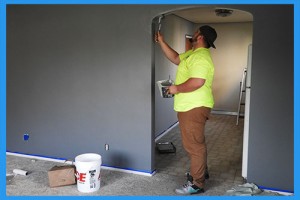Here, at Fifthroom.com, we know that remodeling your house can be super stressful, so we decided to do some research on the best way to plan for your project.
Remodeling your home can take both time and money, so you’ll want to get an understanding on how to best use those resources to achieve the greatest results. You’ll want to create a detailed timeline as well as a maximum budget. A good suggestion would be to hire an expert to plan your project as well as design and manage the budget, but it’s still a good idea for you to know the ins and outs of what you’re working with.

When remodeling a house, it can typically take 3-6 months to complete. Depending on the size and complexity of the project, this timeline can vary and other factors such as budget, workers, and conditions, can greatly impact how it goes. One good rule of thumb is to consider every $10,000 spent as 1-2 weeks’ worth of work to complete.
Before doing the work, you’ll want to plan, consider and acquire permits, hire contractors, and the like. Be sure to allot yourself enough time to get the job done properly.
A Common Home Modeling Timeline:
Planning: 1 Month
Demolition: 2 Weeks
HVAC, Electrical, & Plumbing: 5 Days
Framing & Drywall: 10 Days
Painting: 1 Week
Cabinets & Fixtures: 1 Week
Windows & Doors: 5 Days
Clean House, Furnace, & Air Vents: 1 Day
Flooring: 1 Week
Trim & Finish: 1 Week
When reviewing the common timeline, you’ll see that the typical remodeling project may take up to 3 months to complete.
We’ll walk you through the steps to get started and from there, you should have a better understanding of what you’re working with.
Step 1: Planning
You’ll first want to establish a budget and make sure that you have enough money to cover the project in its entirety. Make sure that you stick to your budget and avoid going over it.
There are various costs that you may be unfamiliar with, so you’ll want to create a list of your needed and wanted items using a spreadsheet. Find the average cost of each item and include it on your list so that you can find an average total and figure out what you can likely afford.
Estimating the cost of labor may be the most difficult task but it will likely account for 20-40% of your total budget. You may also want to account 10-20% contingency as well for the size and complexity of your project. Keeping a safety net is important, and you may be able to keep any unused money for something else when your project is complete.
The majority of issues arise during the demolition and framing/drywall process. This is when you may encounter common problems such as mold, defective wiring, leaking pipes, termite damage, and foundation damage.
Some projects you may be able to do yourself, but for things like plumbing, electrical work, HVAC, and working with load-bearing walls, you’ll want to hire a professional.
When you need to hire a professional, you’ll want to research the best contractor for the job. Ideally, a good contractor will have prior experience with the task that needs done, be licensed and insured to do the work, and be able to acquire all the necessary permits for you.
Step 2: Demolition
When beginning demolition, you’ll need to consider the best way to demolish as well as methods of disposal. Minimizing the mess will greatly improve the process and working conditions. You’ll likely need to rent a dumpster.
If you choose to do demolition work yourself, follow safety precautions and be very cautious when doing the work as it can be quite dangerous.
Step 3: HVAC, Electrical, and Plumbing
Once demolition is completed, you can begin doing any work needed behind walls and underneath floors. At this time, electrical and plumbing inspectors may need to come and inspect your home and ensure that you have up to date systems.
Be sure to complete these particular jobs before doing any paint work, flooring, or drywall because they could be damaged.
Step 4: Framing and Drywall
After completing all HVAC, Electrical, and Plumbing, you can begin framing and drywall. The process of drywall involves hanging sheets of drywall, applying a drywall compound, letting it dry, and sanding it smooth. Contractors are quite helpful when it comes to moving and constructing walls, adding support beams, and dealing with window and door openings.
Step 5: Painting
When the drywall is completed and smoothed out, you can begin painting. This is a project that you can do yourself but may achieve better results with a professional. Be cautious of other projects that could be damaged by painting.
Step 6: Cabinets and Fixtures
At this time, you can start installation on lighting, cabinets, bathtubs, toilets, sinks, showers, and the like. You can have a lot of fun picking out different styles and bringing your vision together.
Step 7: Install Windows and Hang Doors
Now you can install your windows and hang doors, but be sure that they all function as they should. Check that your doors can swing freely before installing any carpet or laminate flooring.
Step 8: Clean House, Furnace, and Air Vents
You can now begin the clean up process on any remaining debris. You may want to have a professional take care of any dust accumulated through renovation in your furnace and air vents. Other areas, you can sweep, vacuum, and dust.
Step 9: Flooring
Flooring should be held off until the end of your project to prevent any possible damage like nicks and scrapes to carpeting, tile, laminate, and other flooring.
Step 10: Trim and Finish Work
After all other work is completed, you can nail door frames, baseboards, trim, and finishes.

At this point, all remodeling should be complete and you can move accessories, appliances, furniture, and decor back in. You may want to have some pictures on hand of what the space looked like before and compare it to the completed renovation. This type of project can be quite overwhelming, but if you break it down into steps, it can be rather manageable. For more insights, check out this article on Hometown Demolition, Create a Home Remodeling Plan in 10 Simple Steps.
Be sure to check out Fifthroom.com for a wide variety of outdoor structures, furniture, and decor to accentuate your newly remodeled space.

0